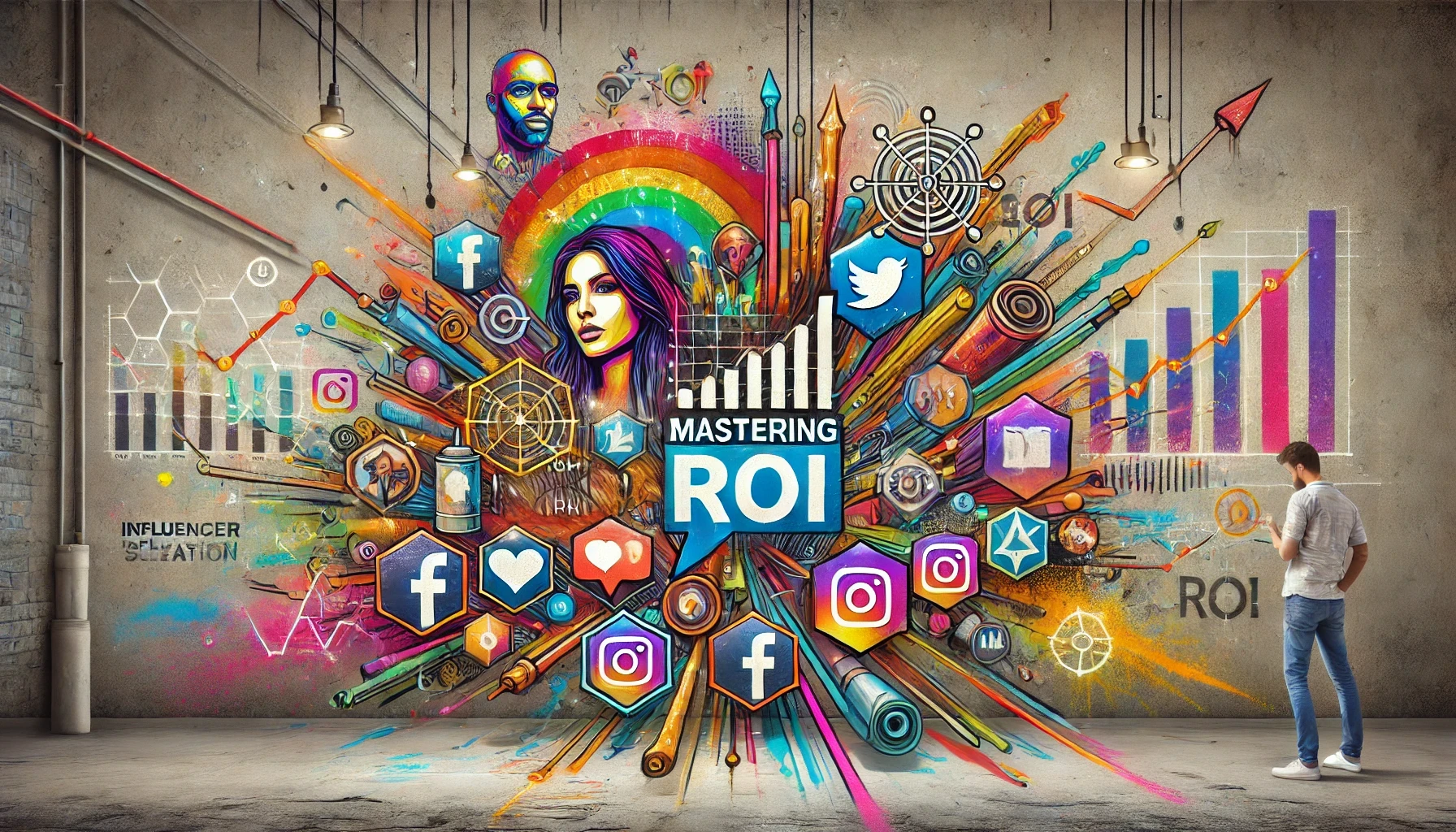
Are you tired of stagnant marketing strategies? Ready to elevate your brand’s influence and boost ROI like never before? The next phase of influencer marketing goes beyond social media, offering a fresh perspective on reaching your target audience effectively. Dive into this blog post to discover innovative approaches that can unlock higher ROI and take your brand to new heights. Learn how to harness the power of influencers in unconventional ways, tapping into untapped markets and maximizing your marketing efforts. Stay ahead of the curve and revolutionize your marketing game with these cutting-edge strategies.
Table of Contents
Influencer Selection Importance
Choosing the Right Partners
When it comes to influencer selection, it is crucial to choose partners who align with your brand’s values. Mismatched partnerships can lead to a negative impact on your brand image and credibility. Look for influencers whose content and style resonate with your target audience.
Consider the relevance of the influencer’s content to your brand. A successful partnership requires authenticity and genuine interest in what the influencer promotes. Engage with influencers who have a strong connection with their followers and can drive meaningful engagement.
- Pros:
- Increased brand credibility
- Higher engagement rates
- Enhanced brand awareness
- Cons:
- Risk of backlash if the partnership seems forced
- Potential damage to brand reputation if the influencer’s values conflict with yours
Aligning with Brand Values
Influencers should embody your brand’s values and messaging. Their online presence should reflect authenticity and trustworthiness, resonating with your target audience. Ensure that their past collaborations and content align with your brand’s ethos.
Look for influencers who have a track record of promoting products or services in a way that feels natural and integrated. Transparency is key in influencer partnerships, as audiences appreciate honesty and authenticity. Make sure the influencer’s values align with yours to maintain brand integrity.
Target Audience Match
Identifying influencers whose followers match your target audience is essential for a successful partnership. Analyze an influencer’s demographics, interests, and engagement metrics to ensure they can effectively reach and influence your desired customer base.
Consider the demographic information provided by influencers, such as age, location, and interests. Look at their engagement rates to gauge how well they connect with their audience. Collaborating with influencers who have a strong overlap with your target market can lead to higher conversion rates and ROI.
- Consider the potential reach of different influencers.
- Evaluate the engagement levels of each influencer.
- Analyze the demographic data to ensure alignment with your target audience.
Strategic Selection for ROI
To maximize ROI, adopt a strategic approach to influencer selection. Utilize data-driven insights to identify influencers who can deliver tangible results for your brand. Look beyond follower counts and prioritize engagement rates, audience quality, and previous campaign success.
Invest time in researching different influencers and their performance metrics across various platforms. Consider working with micro-influencers who may have a smaller following but boast higher engagement rates within niche communities. This targeted approach can result in more meaningful connections with your target audience.
Crafting High-Impact Content

Engaging Content Creation
Creating engaging content is crucial in influencer marketing to capture the audience’s attention effectively. Content that resonates with the target market can significantly boost engagement rates and drive conversions. By utilizing a mix of visuals, videos, and interactive elements, influencers can create a diverse range of content formats to keep their audience interested.
To ensure engagement, influencers should focus on understanding their audience demographics, preferences, and behaviors. Tailoring content to match these insights helps in establishing a deeper connection with followers. Incorporating user-generated content or running interactive campaigns like contests and polls can further enhance engagement levels.
Consistency is key when it comes to engaging content creation. By maintaining a regular posting schedule and delivering valuable information consistently, influencers can build trust and loyalty with their audience. Moreover, responding to comments, messages, and feedback promptly fosters a sense of community and encourages active participation from followers.
Storytelling and Authenticity
Storytelling plays a vital role in influencer marketing as it allows influencers to connect with their audience on a personal level. Sharing authentic stories and experiences can evoke emotions and create a lasting impact on followers. By weaving brand messages into compelling narratives, influencers can subtly promote products or services without appearing salesy.
Authenticity is the cornerstone of successful influencer marketing campaigns. Followers value genuine recommendations and transparent collaborations between influencers and brands. When influencers share personal anecdotes or testimonials related to a brand, it adds credibility and authenticity to the promotional content.
Incorporating storytelling techniques such as narratives, testimonials, or behind-the-scenes glimpses can humanize the brand and make it more relatable to the audience. By showcasing real-life experiences and emotions, influencers can establish a deeper connection with their followers and drive stronger brand affinity.
Enhancing Brand Messaging
Enhancing brand messaging through influencer marketing involves aligning the influencer’s content with the brand’s core values and objectives. By integrating key brand messages seamlessly into content, influencers can reinforce brand identity and awareness among their audience. Consistent messaging helps in strengthening brand recall and recognition over time.
Collaborating with influencers who resonate with the brand’s values and aesthetics is essential for maintaining brand consistency across all marketing channels. Influencers who authentically embody the brand’s ethos are more likely to deliver cohesive messaging that aligns with the brand’s overall image and positioning in the market.
Striking a balance between promotional content and value-driven information is crucial for enhancing brand messaging. Influencers should aim to educate, entertain, or inspire their audience while subtly integrating brand messages within their content. This approach ensures that promotional efforts feel organic and seamless, leading to higher engagement and conversion rates.
Data-Driven ROI Enhancement

Implementing Data Decisions
To enhance the return on investment (ROI) in influencer marketing, brands can implement data-driven decisions. By analyzing consumer behavior and engagement metrics, companies can tailor their strategies effectively. Utilizing tools like Google Analytics and social media insights helps in making informed decisions.
Influencer marketing campaigns can benefit from data-driven decision-making by identifying the most effective content types and distribution channels. By tracking key performance indicators (KPIs), such as click-through rates and conversion rates, brands can optimize their campaigns for better results. This approach allows for real-time adjustments to maximize ROI.
Moreover, by leveraging data analytics, brands can personalize their influencer marketing efforts. Understanding audience demographics and preferences enables targeted campaigns that resonate with consumers. This level of personalization leads to higher engagement rates and ultimately boosts ROI.
Performance Metrics Analysis
Analyzing performance metrics is crucial for evaluating the effectiveness of influencer marketing campaigns. Metrics such as engagement rates, reach, and conversion rates provide valuable insights into campaign performance. Brands can use this data to identify successful strategies and areas for improvement.
Tracking performance metrics allows brands to measure the impact of influencer collaborations accurately. By comparing different campaigns’ results, companies can determine which influencers drive the highest ROI. This analysis helps in allocating resources effectively and partnering with influencers who deliver the best results.
Performance metrics analysis enables brands to optimize their content strategy based on what resonates most with their target audience. By monitoring metrics like likes, shares, and comments, companies can refine their content to increase engagement levels. This iterative process leads to continuous improvement in ROI.
Insights for Improvement
Gaining insights from data analysis is essential for continually improving influencer marketing ROI. By identifying trends and patterns in consumer behavior, brands can adapt their strategies to meet evolving market demands. These insights help in staying ahead of competitors and maintaining a competitive edge.
Furthermore, analyzing data provides valuable feedback on influencer partnerships’ effectiveness. Brands can evaluate which collaborations yield the highest ROI and replicate successful strategies in future campaigns. This data-driven approach ensures that brands invest resources wisely for optimal results.
Exploring New Platforms
Beyond Social Media
Influencer marketing is evolving beyond social media, expanding to new platforms like podcasts and live streams. Brands are leveraging these platforms to reach a wider audience. Podcasts offer a unique opportunity for influencers to engage with their followers in a more intimate setting. Live streams allow real-time interaction, fostering a deeper connection between influencers and their audience.
Podcasts provide a platform for influencers to share in-depth knowledge and insights, establishing themselves as thought leaders in their niche. This form of content consumption is on the rise, offering a passive yet engaging way for audiences to connect with influencers. Brands can tap into this trend by sponsoring podcast episodes or collaborating with influencers on exclusive content.
On the other hand, live streams create a sense of immediacy and authenticity, giving audiences a behind-the-scenes look at an influencer’s life. Viewers can interact through comments and live chats, making the experience more interactive and personal. Brands can integrate product placements or sponsored segments seamlessly into live streams, reaching audiences in a non-intrusive way.
Gen Z Engagement
To unlock higher ROI in influencer marketing, brands need to focus on Gen Z engagement strategies. Gen Z values authenticity and transparency, gravitating towards influencers who align with their values. Collaborating with micro-influencers who have a genuine connection with their audience can yield better results than working with mega-influencers who may come across as less authentic.
Micro-influencers resonate well with Gen Z because of their relatable content and niche focus. These influencers often have a smaller but highly engaged following, leading to higher conversion rates for brands. By partnering with micro-influencers who share common interests with Gen Z consumers, brands can establish credibility and trust within this demographic.
Moreover, Gen Z prefers user-generated content (UGC) that feels organic and unfiltered. Brands can encourage their audience to create UGC by launching challenges or contests that prompt users to showcase their creativity. Leveraging UGC not only boosts engagement but also builds a sense of community around the brand. When Gen Z sees authentic content created by their peers, they are more likely to trust the brand and make purchasing decisions based on recommendations from fellow consumers.
UGC Benefits
User-generated content offers several benefits for brands looking to enhance their influencer marketing strategy. Firstly, UGC serves as social proof, showcasing real customers using products or services in everyday situations. This type of content is perceived as more trustworthy and genuine, influencing purchasing decisions positively.
Secondly, UGC helps in building brand loyalty by involving customers in the brand’s storytelling process. When users see their content featured by a brand or influencer, they feel valued and connected to the brand on a deeper level. This emotional connection leads to long-term relationships with customers, fostering loyalty and advocacy.
Lastly, UGC boosts engagement across social media platforms, driving conversations and interactions among followers. Brands can leverage UGC to spark discussions, encourage user participation, and create a sense of community around their products or services. By incorporating UGC into their influencer marketing campaigns, brands can amplify their reach and impact among target audiences.
Advanced ROI Techniques
SEO and Algorithm Optimization
To maximize influencer marketing ROI, focus on SEO strategies to improve visibility and reach. Utilize targeted keywords in influencer content for better search engine rankings. Implement backlinking techniques to enhance website authority and boost traffic.
Engage influencers who understand algorithm trends on various platforms. Collaborate with creators who can adapt to algorithm changes swiftly, ensuring continuous engagement. Leverage data analytics to track performance and optimize influencer campaigns for higher ROI.
Consider partnering with influencers who have experience in paid amplification strategies. Incorporate boosted posts and sponsored content to expand reach and drive conversions. Allocate budget for paid promotions to elevate brand awareness and increase ROI through strategic targeting.
Paid Amplification
Utilize paid ads on social media platforms to amplify influencer content and increase visibility. Invest in targeted advertising to reach specific audiences aligned with your brand’s demographics. Collaborate with influencers to create engaging ad content that resonates with viewers.
Implement retargeting strategies to re-engage users who have interacted with influencer posts but not converted. Utilize custom audiences based on user behavior to deliver personalized ads for higher conversion rates. Monitor ad performance closely to adjust strategies for optimal ROI.
Partner with influencers who prioritize transparency and authenticity in their content creation. Work with creators who disclose sponsored partnerships clearly to build trust with their audience. Authenticity fosters long-term relationships with followers, leading to sustainable ROI growth.
Transparency and Authenticity
Foster transparency by providing influencers with clear guidelines on brand messaging and values. Encourage creators to align their content with your brand’s ethos while maintaining their unique voice. Transparent collaborations build credibility and trust among consumers, driving higher engagement and ROI.
Establish authentic relationships with influencers based on mutual respect and shared goals. Prioritize partnerships with creators who genuinely resonate with your brand’s values and mission. Authentic collaborations result in genuine endorsements that resonate with audiences, driving organic growth and maximizing ROI.
Leveraging User-Generated Content
UGC Ads Unlocking
User-generated content (UGC) ads are a powerful tool for brands to enhance their marketing strategies. By repurposing content created by consumers, brands can establish authenticity and trust with their audience. These ads often outperform traditional branded content, leading to higher engagement rates and increased conversions.
Utilizing UGC in advertising campaigns can significantly boost brand credibility. When consumers see real people using and endorsing products or services, it creates a sense of authenticity that resonates with them. This authenticity is crucial in today’s market where consumers are increasingly wary of traditional advertising tactics. Brands that incorporate UGC into their ads can build stronger connections with their target audience.
One of the key advantages of UGC ads is their ability to drive higher engagement levels. Consumers are more likely to interact with content that features real people and genuine experiences. By showcasing user-generated content in ads, brands can capture the attention of their audience and encourage them to participate in the brand’s story. This interactive element not only increases engagement but also fosters a sense of community around the brand.
Incorporating UGC ads into marketing strategies requires a well-thought-out approach. Brands need to identify the most compelling user-generated content that aligns with their brand values and messaging. By selecting relevant and impactful content, brands can effectively leverage UGC to enhance their advertising efforts. Brands should ensure that the user-generated content they use complies with legal regulations and respects the privacy rights of the individuals featured.
Brand Engagement Strategies
When it comes to brand engagement strategies, leveraging user-generated content can be a game-changer. Brands that actively involve their audience in creating content not only increase engagement but also foster a sense of community and loyalty. By encouraging consumers to share their experiences with the brand, companies can create a two-way dialogue that strengthens relationships and builds trust.
Engaging with consumers through UGC allows brands to tap into the creativity and authenticity of their audience. When consumers see their content being featured by a brand, it creates a sense of validation and recognition. This recognition motivates consumers to continue engaging with the brand and sharing their experiences, leading to a cycle of positive reinforcement that benefits both parties.
Implementing effective brand engagement strategies involves more than just showcasing user-generated content; it requires ongoing interaction and communication with consumers. Brands should actively respond to user-generated content, whether through comments, likes, or shares. This level of engagement demonstrates that the brand values its customers’ contributions and is committed to building meaningful relationships with them.
Understanding Metrics Role
Influencer Marketing ROI Metrics
Influencer marketing ROI metrics are crucial for evaluating the effectiveness of campaigns. Brands use various metrics like engagement rates, click-through rates, and conversion rates. These metrics provide insights into how well an influencer’s content resonates with the audience.
One key metric in influencer marketing is the return on investment (ROI). It measures the revenue generated compared to the amount spent on the campaign. Tracking ROI helps brands understand the profitability of their influencer partnerships and make informed decisions for future collaborations.
Another essential metric is engagement rate, which indicates how actively the audience interacts with an influencer’s content. A high engagement rate signifies a strong connection between the influencer and their followers, leading to increased brand awareness and loyalty.
Role of Metrics in ROI
Metrics play a vital role in determining the success of influencer marketing campaigns. By analyzing metrics such as reach, engagement, and conversions, brands can measure the impact of their collaborations. These insights enable brands to optimize their strategies for better ROI.
Analyzing metrics also helps brands identify high-performing influencers and replicate successful partnerships. By leveraging data-driven insights, brands can allocate resources effectively and maximize the returns on their influencer marketing investments.
Moreover, metrics provide valuable feedback for influencers to refine their content strategy. By understanding which types of content drive the most engagement and conversions, influencers can tailor their approach to better align with brand objectives.
Risks in Influencer Marketing

In the realm of influencer marketing, various risks can pose challenges to the success of campaigns. One significant risk is the authenticity of influencers, as some may not genuinely align with the brand they promote. This can lead to a lack of trust from the audience and ultimately impact ROI.
Another risk is the potential for influencer partnerships to backfire due to unforeseen circumstances. For instance, if an influencer engages in controversial behavior, it can tarnish the brand’s reputation by association. Such incidents highlight the importance of thoroughly vetting influencers before collaborating with them.
Moreover, the dynamic nature of social media platforms poses a risk in influencer marketing campaigns. Algorithms constantly change, affecting reach and engagement rates. Brands must adapt quickly to these changes to ensure their campaigns remain effective and reach the intended audience.
To identify potential risks in influencer marketing, brands should conduct thorough research on influencers before partnering with them. This includes analyzing their past collaborations, audience demographics, and engagement rates. By understanding an influencer’s history and performance, brands can assess the likelihood of success and potential risks involved.
Monitoring industry trends and shifts in consumer behavior is crucial for identifying emerging risks. By staying informed about the latest developments in influencer marketing, brands can proactively address potential challenges before they escalate. This proactive approach helps mitigate risks and ensures campaigns are aligned with current market dynamics.
Furthermore, engaging with metrics discussed in the previous section plays a vital role in identifying potential risks. By closely monitoring key performance indicators (KPIs) such as engagement rate, reach, and conversions, brands can detect early signs of underperformance or discrepancies. This data-driven approach enables brands to make informed decisions and pivot strategies to mitigate risks effectively.
One effective strategy for mitigating marketing risks in influencer campaigns is to establish clear contractual agreements with influencers. These agreements should outline expectations, deliverables, and guidelines to ensure both parties are aligned on campaign objectives. Clear communication and transparency help minimize misunderstandings that could lead to risks.
Moreover, diversifying influencer partnerships can reduce reliance on a single individual or platform, spreading out risks across multiple collaborators. By working with a mix of macro and micro-influencers across various channels, brands can mitigate the impact of potential setbacks and maintain campaign momentum.
Ongoing monitoring and evaluation of influencer performance throughout a campaign are essential for mitigating risks. By tracking metrics regularly and adjusting strategies based on real-time data, brands can address issues promptly and optimize campaign performance. This agile approach allows brands to adapt to changing circumstances and mitigate risks effectively.
Future Steps for ROI Improvement
Continuous Strategy Enhancement
To maximize ROI in influencer marketing, companies must continuously enhance their strategies. By regularly analyzing performance metrics, brands can identify areas needing improvement. Implementing data-driven decisions based on engagement rates and conversion metrics is crucial.
Engaging with influencers who resonate with the target audience ensures authenticity and boosts ROI. Collaborating with micro-influencers can yield higher returns due to their niche audiences. Regularly refreshing content and messaging helps maintain audience interest and drives conversions.
Maintaining a flexible approach is essential in influencer marketing. Adapting strategies based on changing trends and consumer behavior enhances ROI. Investing in influencer training programs can empower partners to create more compelling content that resonates with followers.
Next Phase Developments
The next phase of influencer marketing beyond social media involves exploring emerging platforms like TikTok and Clubhouse. Leveraging these platforms can reach new audiences and drive higher engagement rates. Brands need to stay updated on the latest trends to remain competitive in the market.
Implementing innovative collaboration strategies such as interactive live streams and virtual events can drive significant ROI growth. Creating exclusive partnerships with influencers can generate buzz and excitement around products or services. Brands should focus on building long-term relationships with influencers for sustained ROI benefits.
Utilizing advanced analytics tools to track campaign performance and audience sentiment is crucial in the next phase of influencer marketing. Brands can leverage data insights to optimize future campaigns and ensure maximum ROI. Embracing automation technologies for content scheduling and performance monitoring streamlines processes and improves efficiency.
Maximizing ROI Recap

Summary of Key Strategies
To maximize ROI in influencer marketing beyond social media, brands need to focus on diversifying their influencer partnerships. Instead of solely relying on social media influencers, brands should explore collaborations with micro-influencers, bloggers, and podcast hosts. This strategy allows brands to reach a wider audience and tap into niche markets that traditional social media influencers may not cover.
Another key strategy is to prioritize long-term relationships with influencers. By nurturing ongoing partnerships, brands can build authentic connections with their audience, leading to higher engagement and conversion rates. Investing in long-term relationships also helps establish trust and credibility, which are crucial for sustained ROI growth in influencer marketing.
Brands should leverage data analytics to track the performance of their influencer campaigns accurately. By analyzing metrics such as engagement rates, click-through rates, and conversion rates, brands can optimize their strategies in real-time. This data-driven approach enables brands to identify high-performing influencers, refine their content strategies, and allocate budgets effectively for maximum ROI.
In summary, diversifying influencer partnerships, prioritizing long-term relationships, and leveraging data analytics are key strategies for maximizing ROI in influencer marketing beyond social media.
Next Steps for Brands
- Invest in Influencer Marketing Platforms: Brands can streamline their influencer partnerships by using dedicated platforms that connect them with a diverse range of influencers. These platforms offer features such as campaign management tools, audience insights, and performance tracking, making it easier for brands to manage multiple influencer collaborations efficiently.
- Experiment with Emerging Platforms: As the influencer marketing landscape evolves, brands should explore opportunities on emerging platforms such as TikTok, Twitch, and Clubhouse. These platforms cater to different demographics and offer unique engagement opportunities that can help brands expand their reach and connect with new audiences.
- Create Authentic Content: To resonate with audiences in the post-social media era, brands must prioritize authenticity in their influencer campaigns. Encouraging influencers to create genuine, relatable content that aligns with the brand’s values can foster stronger connections with consumers and drive higher ROI.
- Measure Success Holistically: Beyond traditional ROI metrics, brands should consider broader indicators of success such as brand sentiment, customer loyalty, and repeat purchases. By taking a holistic approach to measuring success, brands can gain a comprehensive understanding of the impact of their influencer marketing efforts.
Closing Thoughts
Influencer marketing’s success hinges on strategic influencer selection, creating captivating content, harnessing data for ROI, exploring diverse platforms, and employing advanced techniques like user-generated content. Understanding metrics and recognizing risks are crucial for future ROI growth. By maximizing these strategies, you can unlock higher ROI beyond social media. Take actionable steps to refine your influencer partnerships, enhance content quality, and analyze metrics meticulously. Embrace innovation and take calculated risks to propel your influencer marketing endeavors to new heights. Your commitment to continuous improvement will drive significant ROI gains and set you apart in the competitive landscape.
Related Article:
Featured Image courtesy of DALL-E by ChatGPT
